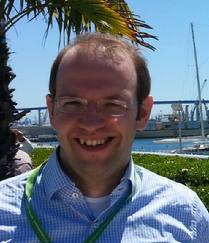
Postdoc
E-mail: g.vandalum@utwente.nl
Telephone: +31 53 489 5365
Fax: +31 53 489 3511
Address: Faculty of Science and Technology
Medical Cell BioPhysics (MCBP)
Building: Carré
Room: CR4435
Drienerlolaan 5
P.O. Box 217
7500 AE Enschede
The Netherlands
Background
Guus van Dalum studied Applied Physics at the university of Twente. His master thesis was on Raman cytometry: The integration and testing of an automated stages into an existing confocal Raman spectrometer to allow the analysis of a larger number of cells. Cells present in human blood where investigated. Distinct spectra for Eosinophils, Basophils and B-lymphocytes where found.
After which he continued at Medical Cell Biophysics as a PHD student and worked on several topics for his PhD thesis, ‘the role and definition of tumor cells in blood’:
We looked into the role of CTCs enumerated with CellSearch in non-metastatic breast and colon cancer patients before surgical removal of the primary tumor and at different time points following surgery. In these studies the blood volume investigated was increased from the standard 7.5 mL of blood to 30 mL of blood to increase sensitivity and patients were followed-up with a median of 5 years. An association between the presence of CTCs in these patients and reduced recurrence free and overall survival was found.
After EpCAM enrichment of cells from 7.5 mL of blood using the CellSearch assay only few of the remaining cells are identified as CTCs. The identity of the remaining cells and factors influencing their frequency were investigated using automated image analysis on archived CellSearch studies.
We also investigated the androgen receptor (AR) expression in the nucleus of CTCs of castration resistant prostate cancer patients using image analysis methods. We confirmed that AR remains expressed in the nucleus of CTCs in patients, who are progressing on novel endocrine treatments. A small number of unidentified cells were found to be AR positive and associated with reduced overall survival.
An alternative to enrichment based on EpCAM is filtration based on size difference between the tumor cells and the blood cells. Due to the difference in size between actual CTC and cell lines it is important not to choose pores with a to large diameter. Filtration and filter parameters were compared to determine suitable conditions for CTC enrichment. This led to an enrichment protocol that successfully enriched spiked cell lines in healthy donor blood. By combining this EpCAM insensitive enrichment method with CellSearch EpCAM+ and EpCAM- CTCs could be identified in the same blood sample and were investigated in metastatic lung cancer patients.
Current projects
Automated circulating tumor cell enumeration
In collaboration with Leonie Zeune and Christoph Brüne from the Applied Analysis group we are working on the automated enumeration of circulating tumor cells in microscopy images.
EpCAM independent Circulating tumor cell enrichment methods
In collaboration with the CTC-Trap and Cancer-ID program we are investigating the clinical relevance of circulating tumor cell enriched using EpCAM independent methods.
